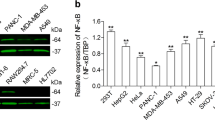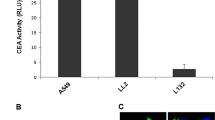Abstract
Adenoviral vectors are considered to be good gene delivery vectors for cancer gene therapy due to their wide host tissue range and cell cycle-independent infectivity. However, the disadvantages include the lack of specificity for cancer cells and the high liver accumulation in vivo. The human CXCR4 gene is expressed at high levels in many types of cancers, but is repressed in the liver. We explored the CXCR4 promoter as a candidate to restrict adenoviral transgene expression to tumor cells with a low expression in host tissues. The luciferase activities in multiple cancer cell lines infected with recombinant adenovirus reAdGL3BCXCR4 or the control vector reAdGL3BCMV revealed that the CXCR4 promoter exhibited relatively high transcriptional activity in a breast cancer cell line, MDA-MB-361, and two ovarian cancer cell lines, OVCAR-3 and SKOV3. ip1, 65% (P=0.0087), 16.7% (P=0.1) and 20% (P=0.0079) compared to that of the CMV promoter, respectively, and low expression, 4.9 and 0.1%, respectively, in both normal cell lines HFBC and HMEC. In addition, CXCR4 had a low expression of luciferase (0.32%) compared to that of the CMV promoter in mouse liver in vivo. The data also revealed that the CXCR4 promoter was a stronger tumor-specific promoter (TSP) than the Cox-2M promoter in primary melanomas obtained from two patients. The CXCR4 promoter is shown to have a ‘tumor-on’ and ‘liver-off’ status in vitro and in vivo, and CXCR4 may prove to be a good candidate TSP for cancer gene therapy approaches for melanoma and breast cancers.
This is a preview of subscription content, access via your institution
Access options
Subscribe to this journal
Receive 12 print issues and online access
$259.00 per year
only $21.58 per issue
Buy this article
- Purchase on Springer Link
- Instant access to full article PDF
Prices may be subject to local taxes which are calculated during checkout




Similar content being viewed by others
References
Brand K et al. Liver-associated toxicity of the HSV-tk/GCV approach and adenoviral vectors. Cancer Gene Ther 1997; 4: 9–16.
van der Eb MM et al. Severe hepatic dysfunction after adenovirus-mediated transfer of the herpes simplex virus thymidine kinase gene and ganciclovir administration. Gene Therapy 1998; 5: 451–458.
Haisma HJ et al. Targeting of adenoviral vectors through a bispecific single-chain antibody. Cancer Gene Ther 2000; 7: 901–904.
Heideman DA et al. Selective gene delivery toward gastric and esophageal adenocarcinoma cells via EpCAM-targeted adenoviral vectors. Cancer Gene Ther 2001; 8: 342–351.
Krasnykh V et al. Genetic targeting of an adenovirus vector via replacement of the fiber protein with the phage T4 fibritin. J Virol 2001; 75: 4176–4183.
Yamamoto M et al. Characterization of the cyclooxygenase-2 promoter in an adenoviral vector and its application for the mitigation of toxicity in suicide gene therapy of gastrointestinal cancers. Mol Ther 2001; 3: 385–394.
Adachi Y et al. A midkine promoter-based conditionally replicative adenovirus for treatment of pediatric solid tumors and bone marrow tumor purging. Cancer Res 2001; 61: 7882–7888.
Nettelbeck DM, Jerome V, Muller R . Gene therapy: designer promoters for tumour targeting. Trends Genet 2000; 16: 174–181.
Rollins BJ . Chemokines. Blood 1997; 90: 909–928.
Wegner SA et al. Genomic organization and functional characterization of the chemokine receptor CXCR4, a major entry co-receptor for human immunodeficiency virus type 1. J Biol Chem 1998; 273: 4754–4760.
Muller A et al. Involvement of chemokine receptors in breast cancer metastasis. Nature 2001; 410: 50–56.
Moore MA . The role of chemoattraction in cancer metastases. Bioessays 2001; 23: 674–676.
Payne AS, Cornelius LA . The role of chemokines in melanoma tumor growth and metastasis. J Invest Dermatol 2002; 118: 915–922.
Murakami T et al. Expression of CXC chemokine receptor-4 enhances the pulmonary metastatic potential of murine B16 melanoma cells. Cancer Res 2002; 62: 7328–7334.
Taichman RS et al. Use of the stromal cell-derived factor-1/CXCR4 pathway in prostate cancer metastasis to bone. Cancer Res 2002; 62: 1832–1837.
Haviv YS et al. Targeting renal cancer via the CXCR4 promoter (submitted).
Alvarez RD et al. Adenoviral-mediated suicide gene therapy for ovarian cancer. Mol Ther 2000; 2: 524–530.
Alvarez RD et al. A cancer gene therapy approach utilizing an anti-erbB-2 single-chain antibody-encoding adenovirus (AD21): a phase I trial. Clin Cancer Res 2000; 6: 3081–3087.
Nettelbeck DM et al. Cox2 promoter for tumor-specific targeting of adenoviral vector to melanoma. Melanoma Res 2003; 13: 287–292.
He TC et al. A simplified system for generating recombinant adenoviruses. Proc Natl Acad Sci USA 1998; 95: 2509–2514.
Acknowledgements
This study was supported by research grants from the National Institute of Health Grants: R01 CA83821, R01 HL67962, K12 HD01261-02 (WRHR) and 5P50 CA83591 (Ovarian SPORE Developmental Grant).
We thank Dr SL Michael for the kind gift of the construct pBSKCAT/CXCR4 1B/4-1, Dr S Boopana for the control cell line HFBC and Dr D Dieckmann for the two primary melanomas P-A and P-B.
Author information
Authors and Affiliations
Rights and permissions
About this article
Cite this article
Zhu, Z., Makhija, S., Lu, B. et al. Transcriptional targeting of adenoviral vector through the CXCR4 tumor-specific promoter. Gene Ther 11, 645–648 (2004). https://doi.org/10.1038/sj.gt.3302089
Received:
Accepted:
Published:
Issue Date:
DOI: https://doi.org/10.1038/sj.gt.3302089
Keywords
This article is cited by
-
High throughput screen for the improvement of inducible promoters for tumor microenvironment cues
Scientific Reports (2022)
-
Understanding and addressing barriers to successful adenovirus-based virotherapy for ovarian cancer
Cancer Gene Therapy (2021)
-
Construction and Quantitative Validation of Chicken CXCR4 Expression Reporter
Molecular Biotechnology (2016)
-
Experimental virotherapy of chemoresistant pancreatic carcinoma using infectivity-enhanced fiber-mosaic oncolytic adenovirus
Cancer Gene Therapy (2014)
-
Exploiting the Intron-splicing Mechanism of Insect Cells to Produce Viral Vectors Harboring Toxic Genes for Suicide Gene Therapy
Molecular Therapy - Nucleic Acids (2012)



